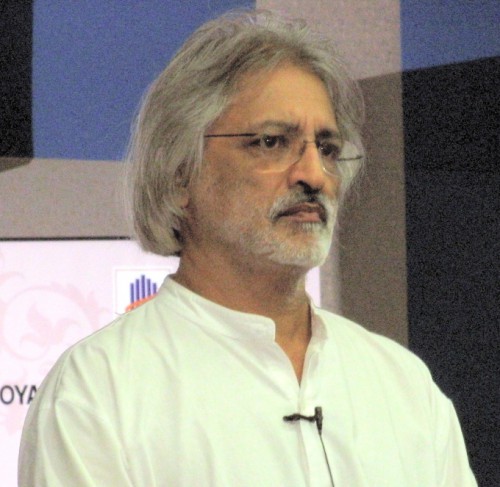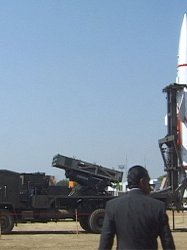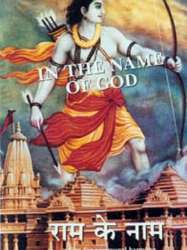Anand Patwardhan est un Acteur, Réalisateur, Scénariste, Producteur, Directeur de la Photographie et Monteur Indien né le 1950

Anand Patwardhan is one of the most acclaimed Indian documentary filmmakers, known for his activism through social action documentaries on topics such as corruption, slum dwellers, nuclear arms race, citizen activism and communalism. Notable films include Bombay: Our City (Hamara Sahar) (1985), In the Name of God (Ram ke Nam) (1992), Father, Son and Holy War (Pitra, Putra aur Dharmayuddha) (1995), War and Peace (Jang aur Aman) (2002) and Jai Bhim Comrade (2011), which have won national and International awards.
Source : Wikidata
Anand Patwardhan

- Infos
- Photos
- Meilleurs films
- Famille
- Personnages
- Récompenses
Biographie
Anand Patwardhan was born in 1950, in Mumbai, Maharashtra. He completed a B.A. in English literature at Bombay University in 1970, a B.A. in Sociology at Brandeis University in 1972, and an M.A. in Communication studies at McGill University in 1982.Le plus souvent avec
Filmographie de Anand Patwardhan (6 films)
Acteur

War and Peace (2002)
, 2h15Réalisé par Anand Patwardhan
Genres Documentaire
Acteurs Anand Patwardhan
Rôle Narrateur
Note79%





The documentary begins with the assassination of Mahatma Gandhi by the religious extremist Nathuram Godse in 1948. The film then describes the years after Indian independence. In a voice-over, Patwardhan describes several events, including the United States' use of the nuclear bomb, the nuclear arms race during the cold war, and India's first nuclear test in 1974. Patwardhan summarizes them in the following manner: "The collapse of socialism saw a revival of bigotry. America had now become our role model." The film then examines the growing nuclear nationalism in India. It covers the Hindu-nationalist rhetoric of the Bharatiya Janata Party that surrounded Indian nuclear weapons tests in 1998. The film covers the "Global Peace March" that occurred following the nuclear tests at Pokhran, and the opposition it faced from activists of the Sangh Parivar. It also covers the rise of religious extremism in both India and Pakistan. Patwardhan travels to Pakistan, where he interviews several people, including school-girls participating in a debate on the use of the bomb. In the second half of the documentary, Patwardhan travels to Japan to interview the hibakusha, survivors of the atomic bombings of Hiroshima and Nagasaki by the United States. The film then moves to the United States, where Patwardhan interviews curators of the Smithsonian Institution. The curators describe how the United States Congress blocked an attempt to create an exhibition on the American use of the atomic bomb on Hiroshima, and the effects of nuclear weapons. A postscript to the film shows the September 11 attacks, and the response of the US.
Réalisateur

Jai Bhim Comrade (2012)
, 3h19Réalisé par Anand Patwardhan
Genres Documentaire
Note83%





Jai Bhim Comrade begins with a description of the Indian caste system and its oppression of the Dalit community. The film includes a song by Dalit poet and activist Vilas Ghogre, followed by a shot of a newspaper clipping describing his suicide in reaction to the Ramabai killings in 1997. The documentary then describes the killings; on 11 July 1997 a statue of B.R. Ambedkar in the Dalit colony of Ramabai had a garland of footwear placed over it, an act considered to be a desecration. An initially peaceful protest was fired upon by a team of Special Reserve Police Force members, killing ten protesters, and other protests later in the day saw further police violence. Commentators stated that the violence was motivated by caste-based prejudices, as the leader of the police team stood accused of several cases of mistreatment of Dalit people. The Dalit singer, poet, and activist Vilas Ghogre hanged himself in protest at the incident. After narrating the incidents surrounding the killing, the documentary follows Patwardhan on his visits to the families of those killed in the firing, as well as to Ghogre's wife. The film tries to reconstruct the incident by interviewing witnesses on both sides. The footage shot by a civilian bystander is used to contradict the description of the incident given by the police.

War and Peace (2002)
, 2h15Réalisé par Anand Patwardhan
Genres Documentaire
Acteurs Anand Patwardhan
Note79%





The documentary begins with the assassination of Mahatma Gandhi by the religious extremist Nathuram Godse in 1948. The film then describes the years after Indian independence. In a voice-over, Patwardhan describes several events, including the United States' use of the nuclear bomb, the nuclear arms race during the cold war, and India's first nuclear test in 1974. Patwardhan summarizes them in the following manner: "The collapse of socialism saw a revival of bigotry. America had now become our role model." The film then examines the growing nuclear nationalism in India. It covers the Hindu-nationalist rhetoric of the Bharatiya Janata Party that surrounded Indian nuclear weapons tests in 1998. The film covers the "Global Peace March" that occurred following the nuclear tests at Pokhran, and the opposition it faced from activists of the Sangh Parivar. It also covers the rise of religious extremism in both India and Pakistan. Patwardhan travels to Pakistan, where he interviews several people, including school-girls participating in a debate on the use of the bomb. In the second half of the documentary, Patwardhan travels to Japan to interview the hibakusha, survivors of the atomic bombings of Hiroshima and Nagasaki by the United States. The film then moves to the United States, where Patwardhan interviews curators of the Smithsonian Institution. The curators describe how the United States Congress blocked an attempt to create an exhibition on the American use of the atomic bomb on Hiroshima, and the effects of nuclear weapons. A postscript to the film shows the September 11 attacks, and the response of the US.

Narmada Diary (1995)
Réalisé par Anand Patwardhan
Genres Documentaire
Thèmes L'environnement, Documentaire sur l'environnement, Documentaire sur les technologies
Note72%





 , 2h
, 2hRéalisé par Anand Patwardhan
Genres Documentaire
Thèmes Documentaire sur le droit
Note84%





The title of the first section is a reference to the ordeal that the Hindu god-king Rama used to test the fidelity of his wife after rescuing her from the demon king Ravana. The segment describes the various interconnected instances of communal violence in India in the years prior to the film. The film opens with the aftermath of the anti-Muslim riots in Bombay that followed the demolition of the Babri Masjid in December 1992. Several Hindu youth are heard speaking to the cameraman, saying that they had enjoyed the killing and looting, and that a list of Muslim individuals had been prepared beforehand, and that some authority figures knew of the plans to target Muslims.

Ram ke Naam (1992)
, 1h15Réalisé par Anand Patwardhan
Genres Documentaire
Note88%





Ram ke Naam explores the VHP's campaign to demolish the Babri Masjid and build a temple to Rama in its place. The film begins with a clip of an organizer describing Advani's rath yatra in 1990. It then shows scenes from the yatra, with young men dressed in saffron seen in Ayodhya, followed by a video prepared by the VHP. The video depicts an incident at the temple in 1949, when an idol of Rama "appeared" inside the mosque. In the VHP's retelling, Rama is shown descending from the sky and miraculously appearing in the mosque, watched by astonished spectators, followed by a member of the VHP telling the same story.

Bombay, Our City (1985)
, 1h15Réalisé par Anand Patwardhan
Genres Documentaire
Thèmes Documentaire sur les villes
Note74%





Scénariste

Jai Bhim Comrade (2012)
, 3h19Réalisé par Anand Patwardhan
Genres Documentaire
Note83%





Jai Bhim Comrade begins with a description of the Indian caste system and its oppression of the Dalit community. The film includes a song by Dalit poet and activist Vilas Ghogre, followed by a shot of a newspaper clipping describing his suicide in reaction to the Ramabai killings in 1997. The documentary then describes the killings; on 11 July 1997 a statue of B.R. Ambedkar in the Dalit colony of Ramabai had a garland of footwear placed over it, an act considered to be a desecration. An initially peaceful protest was fired upon by a team of Special Reserve Police Force members, killing ten protesters, and other protests later in the day saw further police violence. Commentators stated that the violence was motivated by caste-based prejudices, as the leader of the police team stood accused of several cases of mistreatment of Dalit people. The Dalit singer, poet, and activist Vilas Ghogre hanged himself in protest at the incident. After narrating the incidents surrounding the killing, the documentary follows Patwardhan on his visits to the families of those killed in the firing, as well as to Ghogre's wife. The film tries to reconstruct the incident by interviewing witnesses on both sides. The footage shot by a civilian bystander is used to contradict the description of the incident given by the police.

War and Peace (2002)
, 2h15Réalisé par Anand Patwardhan
Genres Documentaire
Acteurs Anand Patwardhan
Rôle Ecrivain
Note79%





The documentary begins with the assassination of Mahatma Gandhi by the religious extremist Nathuram Godse in 1948. The film then describes the years after Indian independence. In a voice-over, Patwardhan describes several events, including the United States' use of the nuclear bomb, the nuclear arms race during the cold war, and India's first nuclear test in 1974. Patwardhan summarizes them in the following manner: "The collapse of socialism saw a revival of bigotry. America had now become our role model." The film then examines the growing nuclear nationalism in India. It covers the Hindu-nationalist rhetoric of the Bharatiya Janata Party that surrounded Indian nuclear weapons tests in 1998. The film covers the "Global Peace March" that occurred following the nuclear tests at Pokhran, and the opposition it faced from activists of the Sangh Parivar. It also covers the rise of religious extremism in both India and Pakistan. Patwardhan travels to Pakistan, where he interviews several people, including school-girls participating in a debate on the use of the bomb. In the second half of the documentary, Patwardhan travels to Japan to interview the hibakusha, survivors of the atomic bombings of Hiroshima and Nagasaki by the United States. The film then moves to the United States, where Patwardhan interviews curators of the Smithsonian Institution. The curators describe how the United States Congress blocked an attempt to create an exhibition on the American use of the atomic bomb on Hiroshima, and the effects of nuclear weapons. A postscript to the film shows the September 11 attacks, and the response of the US.
 , 2h
, 2hRéalisé par Anand Patwardhan
Genres Documentaire
Thèmes Documentaire sur le droit
Rôle Ecrivain
Note84%





The title of the first section is a reference to the ordeal that the Hindu god-king Rama used to test the fidelity of his wife after rescuing her from the demon king Ravana. The segment describes the various interconnected instances of communal violence in India in the years prior to the film. The film opens with the aftermath of the anti-Muslim riots in Bombay that followed the demolition of the Babri Masjid in December 1992. Several Hindu youth are heard speaking to the cameraman, saying that they had enjoyed the killing and looting, and that a list of Muslim individuals had been prepared beforehand, and that some authority figures knew of the plans to target Muslims.

Ram ke Naam (1992)
, 1h15Réalisé par Anand Patwardhan
Genres Documentaire
Note88%





Ram ke Naam explores the VHP's campaign to demolish the Babri Masjid and build a temple to Rama in its place. The film begins with a clip of an organizer describing Advani's rath yatra in 1990. It then shows scenes from the yatra, with young men dressed in saffron seen in Ayodhya, followed by a video prepared by the VHP. The video depicts an incident at the temple in 1949, when an idol of Rama "appeared" inside the mosque. In the VHP's retelling, Rama is shown descending from the sky and miraculously appearing in the mosque, watched by astonished spectators, followed by a member of the VHP telling the same story.
Producteur

Jai Bhim Comrade (2012)
, 3h19Réalisé par Anand Patwardhan
Genres Documentaire
Rôle Producteur
Note83%





Jai Bhim Comrade begins with a description of the Indian caste system and its oppression of the Dalit community. The film includes a song by Dalit poet and activist Vilas Ghogre, followed by a shot of a newspaper clipping describing his suicide in reaction to the Ramabai killings in 1997. The documentary then describes the killings; on 11 July 1997 a statue of B.R. Ambedkar in the Dalit colony of Ramabai had a garland of footwear placed over it, an act considered to be a desecration. An initially peaceful protest was fired upon by a team of Special Reserve Police Force members, killing ten protesters, and other protests later in the day saw further police violence. Commentators stated that the violence was motivated by caste-based prejudices, as the leader of the police team stood accused of several cases of mistreatment of Dalit people. The Dalit singer, poet, and activist Vilas Ghogre hanged himself in protest at the incident. After narrating the incidents surrounding the killing, the documentary follows Patwardhan on his visits to the families of those killed in the firing, as well as to Ghogre's wife. The film tries to reconstruct the incident by interviewing witnesses on both sides. The footage shot by a civilian bystander is used to contradict the description of the incident given by the police.

War and Peace (2002)
, 2h15Réalisé par Anand Patwardhan
Genres Documentaire
Acteurs Anand Patwardhan
Rôle Producteur
Note79%





The documentary begins with the assassination of Mahatma Gandhi by the religious extremist Nathuram Godse in 1948. The film then describes the years after Indian independence. In a voice-over, Patwardhan describes several events, including the United States' use of the nuclear bomb, the nuclear arms race during the cold war, and India's first nuclear test in 1974. Patwardhan summarizes them in the following manner: "The collapse of socialism saw a revival of bigotry. America had now become our role model." The film then examines the growing nuclear nationalism in India. It covers the Hindu-nationalist rhetoric of the Bharatiya Janata Party that surrounded Indian nuclear weapons tests in 1998. The film covers the "Global Peace March" that occurred following the nuclear tests at Pokhran, and the opposition it faced from activists of the Sangh Parivar. It also covers the rise of religious extremism in both India and Pakistan. Patwardhan travels to Pakistan, where he interviews several people, including school-girls participating in a debate on the use of the bomb. In the second half of the documentary, Patwardhan travels to Japan to interview the hibakusha, survivors of the atomic bombings of Hiroshima and Nagasaki by the United States. The film then moves to the United States, where Patwardhan interviews curators of the Smithsonian Institution. The curators describe how the United States Congress blocked an attempt to create an exhibition on the American use of the atomic bomb on Hiroshima, and the effects of nuclear weapons. A postscript to the film shows the September 11 attacks, and the response of the US.

Ram ke Naam (1992)
, 1h15Réalisé par Anand Patwardhan
Genres Documentaire
Rôle Producteur
Note88%





Ram ke Naam explores the VHP's campaign to demolish the Babri Masjid and build a temple to Rama in its place. The film begins with a clip of an organizer describing Advani's rath yatra in 1990. It then shows scenes from the yatra, with young men dressed in saffron seen in Ayodhya, followed by a video prepared by the VHP. The video depicts an incident at the temple in 1949, when an idol of Rama "appeared" inside the mosque. In the VHP's retelling, Rama is shown descending from the sky and miraculously appearing in the mosque, watched by astonished spectators, followed by a member of the VHP telling the same story.

Bombay, Our City (1985)
, 1h15Réalisé par Anand Patwardhan
Genres Documentaire
Thèmes Documentaire sur les villes
Rôle Producteur
Note74%





 Connexion
Connexion
